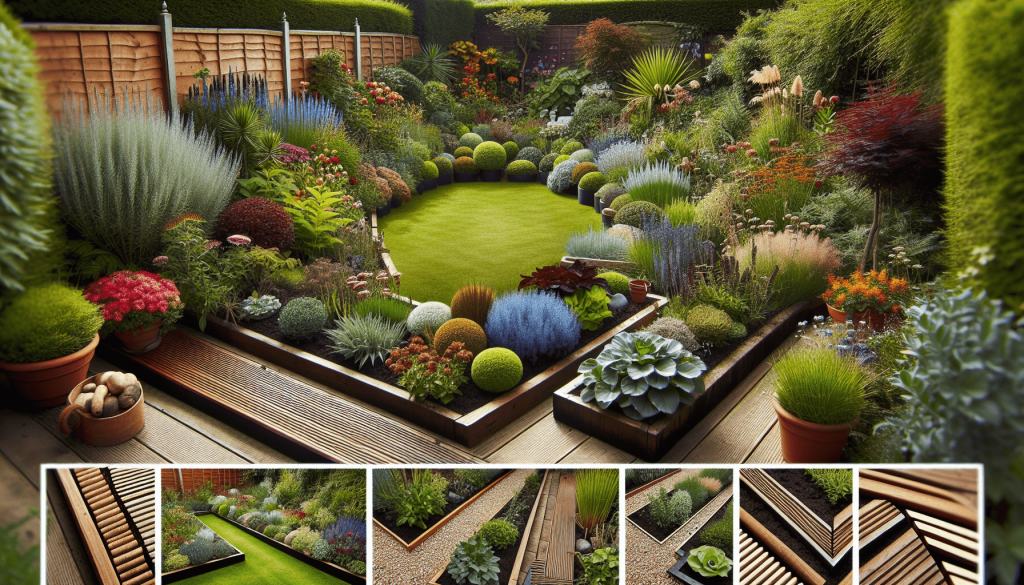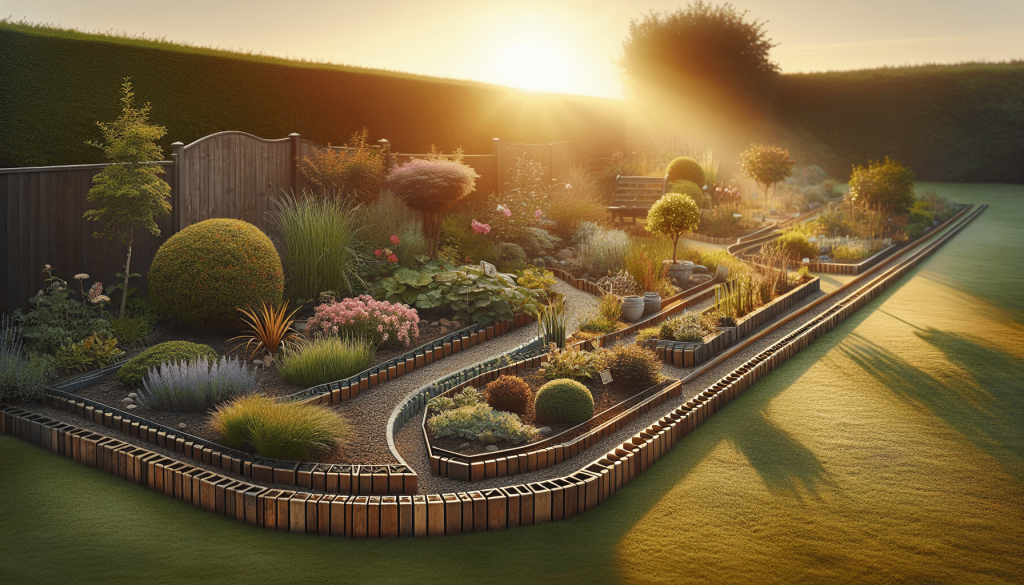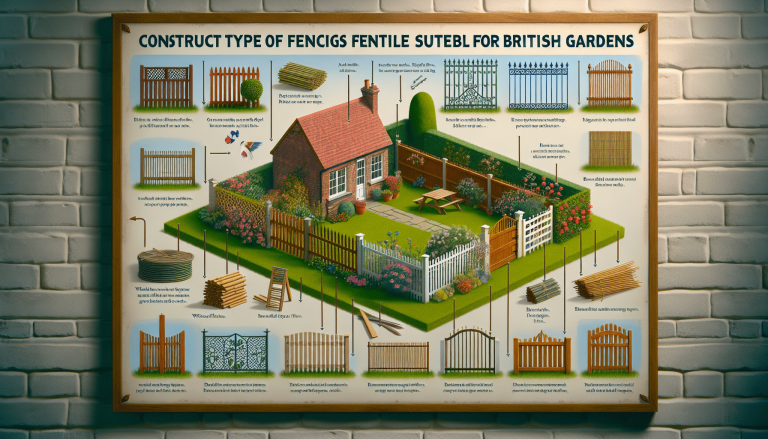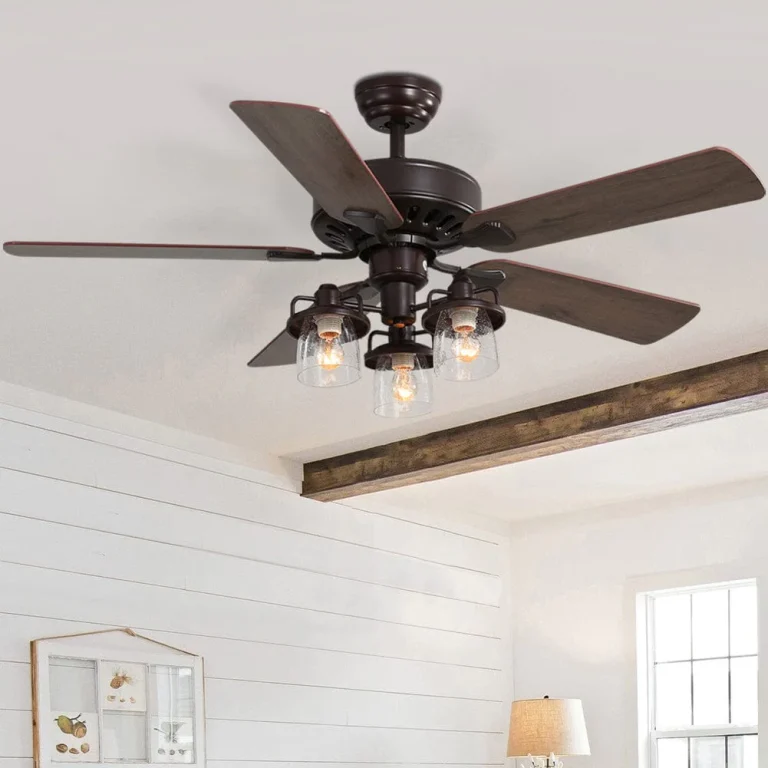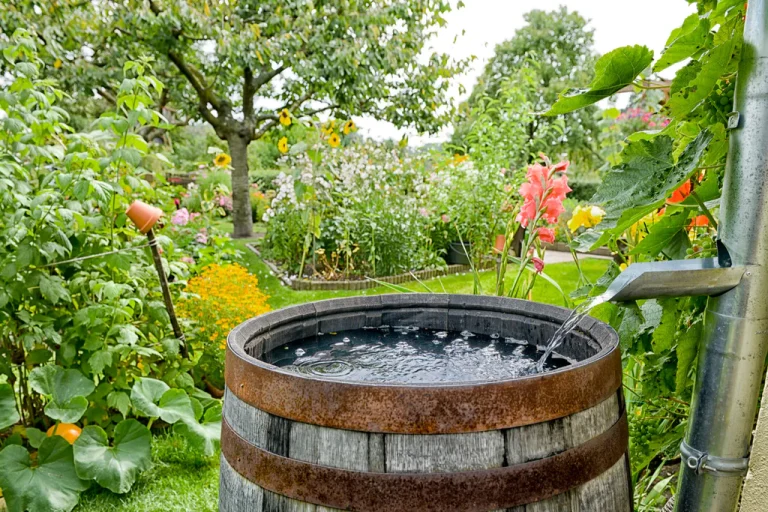Have you ever wondered how to choose the perfect type of garden edging for your beautiful garden in the UK? With so many options available, it can often be overwhelming to make a decision. But fear not, for this article will guide you through the process and help you select the right garden edging that suits your style, budget, and practical needs. From classic materials like bricks and stones to modern alternatives like metal and plastic, we will explore the pros and cons of each type, giving you all the information you need to make an informed choice. So, let’s roll up our sleeves and get ready to transform your garden into a stunning masterpiece with the perfect garden edging!
Table of Contents
ToggleConsider the Purpose of the Garden Edging
When choosing garden edging, it is essential to consider its purpose. Garden edging serves multiple functions, including defining flower beds, separating different areas within the garden, creating pathways, controlling weeds, and enhancing the overall aesthetic appeal.
Defining flower beds
One of the primary purposes of garden edging is to define flower beds. By creating a distinct border around the beds, you can prevent the soil from eroding and ensure that the plants remain confined to their designated area. This helps to maintain a neat and organized appearance in your garden.
Separating different areas
Garden edging can also be used to separate different areas within your garden, such as a vegetable patch, a play area for children, or a relaxation space. By clearly delineating these zones, you can create a well-structured and functional garden layout.
Creating pathways
Garden edging can be used to create pathways, guiding you and your guests through the garden. Whether you prefer straight or curved edges, a well-defined pathway not only adds visual interest but also ensures safe and easy navigation within your garden.
Controlling weeds
Weeds can quickly infiltrate your garden and compete with your desired plants for nutrients and sunlight. Garden edging helps to create a barrier that prevents weeds from encroaching into your flower beds or other designated areas. This can significantly reduce the amount of time and effort required for weed maintenance.
Enhancing the aesthetic appeal
Lastly, garden edging plays a crucial role in enhancing the overall aesthetic appeal of your garden. Whether you prefer a rustic, formal, or contemporary style, the right choice of garden edging can complement your garden’s design theme and create a polished and cohesive look.
Evaluate the Available Materials
There are various materials available for garden edging, each with its own advantages and considerations. By evaluating the available materials, you can determine which one best meets your needs and preferences.
Wood
Wooden garden edging offers a natural and charming look, blending seamlessly with green surroundings. It is relatively easy to install and can be customized to fit your desired shape and size. However, wood requires regular maintenance to prevent rotting and warping, as well as occasional refinishing to maintain its appearance.
Metal
Metal edging is durable and provides a sleek and modern look. It is available in various materials such as steel, aluminum, or wrought iron. Metal edging is long-lasting and requires minimal maintenance. However, it can be more expensive compared to other materials and may not be as flexible for curved edges or intricate designs.
Stone
Stone garden edging offers a timeless and sophisticated appearance. It can be crafted from natural stones like limestone or granite or be manufactured as concrete pavers that mimic the look of natural stone. Stone edging is durable and low-maintenance, but it can be more labor-intensive to install, especially if the stones are heavy or irregularly shaped.
Plastic
Plastic edging is a cost-effective option that is easy to install and maintain. It is available in various colors and designs, allowing for flexibility in customization. Plastic edging is generally suitable for straight edges and simple garden designs. However, it may not have the same level of durability and longevity as other materials.
Concrete
Concrete garden edging offers a versatile and customizable option. It can be poured, stamped, or molded into various shapes and sizes. Concrete edging is durable, long-lasting, and requires minimal maintenance. However, it may require professional installation and can be more expensive compared to other materials.
Brick
Brick edging provides a classic and elegant look to your garden. It is durable and requires little maintenance. Bricks can be arranged in different patterns, allowing for creative designs. However, brick edging can be time-consuming to install and may not be as flexible for curved edges.
Assess the Cost and Maintenance
When choosing garden edging, it is important to consider the cost and maintenance requirements associated with each material. Understanding the initial cost, long-term maintenance, durability, and potential for repairs and replacements will help you make an informed decision.
Initial cost
The initial cost of garden edging varies depending on the material. Wood and plastic edging tend to be more affordable options, while metal and stone edging may be more expensive. Concrete and brick edging can also have a higher upfront cost, especially if professional installation is required.
Long-term maintenance
Maintenance requirements differ for each type of garden edging. Wood edging may require regular sealing and occasional refinishing, while metal and stone edging generally require minimal maintenance. Plastic edging is low-maintenance but may not have the same longevity as other materials. The durability and longevity of concrete and brick edging make them low maintenance options.
Durability
Consider the durability of the materials when selecting garden edging. Wood may be susceptible to rot and warping, while metal and stone are generally more durable. Plastic can endure weather and UV exposure to a certain extent, but its lifespan may be shorter. Concrete and brick are highly durable and can withstand various weather conditions.
Potential for repairs and replacements
It is also important to consider the potential for repairs and replacements over time. Wood may require occasional replacement due to rotting or damage. Metal and stone edging are less likely to require repairs but may need adjustments if the soil settles. Plastic may need to be replaced more frequently due to wear and tear. Concrete and brick edging are sturdy and may require minimal repairs or replacements.
Think About the Design
The design of garden edging plays a significant role in enhancing the overall aesthetics of your garden. Consider the following factors when selecting your preferred design:
Straight or curved edges
Decide whether you prefer straight or curved edges for your garden. Straight edges offer a clean and formal look, while curved edges add softness and a more natural feel. Some materials may be better suited for creating certain edge shapes, so keep that in mind when making your choice.
Height and width
Consider the desired height and width of your garden edging. Taller edging can provide more visual impact, while lower edging offers a more subtle border. The width of the edging should be proportional to the size of your flower beds or pathways.
Color and finish
Choose a color and finish that complements your garden’s overall aesthetic. Natural tones, such as wood or stone, can blend well with various garden styles. Alternatively, bold and vibrant colors can create a striking contrast or focal point in your garden.
Compatibility with garden style
Consider how well the chosen edging material and design align with your garden style. For example, metal edging may be more suitable for contemporary or minimalist gardens, while stone edging complements traditional or cottage-style gardens. The design should harmonize with the overall theme and atmosphere you want to achieve.
Flexibility for future modifications
If you anticipate making changes to your garden layout in the future, consider the flexibility of the chosen edging material. Some materials, such as plastic or metal, can be easily repositioned or adjusted, accommodating any future modifications to your garden design.
Consider the Climate and Weather Conditions
Understanding the climate and weather conditions in your area is crucial when selecting garden edging. Different materials respond differently to various weather elements, so consider the following factors:
Rainfall and humidity
If you live in an area with high rainfall or humidity, choose a material that can withstand moisture without deteriorating or rotting. Metal, stone, concrete, and brick are generally more resilient to water exposure, while wood and some plastics may be more prone to damage.
Temperature fluctuations
Extreme temperature fluctuations can impact the durability of garden edging. Materials such as metal, stone, concrete, and brick are better equipped to handle temperature changes without significant damage. Wood may expand or contract with temperature changes, potentially leading to warping or cracking.
Frost and freeze-thaw cycles
In regions with freezing temperatures and frost, the chosen edging material should be able to withstand freeze-thaw cycles. Stone, concrete, and brick have high resistance to freeze-thaw damage. Metal edging may be susceptible to corrosion if exposed to de-icing salts, while wood and some plastics may be less resilient to freezing conditions.
UV exposure
UV exposure can cause fading and deterioration of certain materials over time. Consider a durable material that can resist UV damage, such as metal, stone, concrete, or brick. Wooden edging may require regular staining or sealing to maintain its appearance and protect it from sun damage.
Resistance to mold and mildew
For areas prone to high humidity or dampness, it is important to choose garden edging materials that are resistant to mold and mildew growth. Metal, stone, concrete, and brick are typically less susceptible to mold and mildew compared to wood or certain plastics.
Research Local Regulations and Codes
Before installing garden edging, it is essential to research and comply with local regulations and codes. This ensures that your chosen edging meets the necessary requirements for safety and accessibility. Consider the following factors:
Permits and restrictions
Certain types of garden edging or specific designs may require permits or have restrictions imposed by your local authorities. Check with your local municipality or homeowner’s association to determine if any permits or guidelines need to be followed.
Requirements for safety and accessibility
Take into account any safety or accessibility requirements set forth by local regulations. This may include ensuring that pathways and ramps are adequately designed, allowing for wheelchair access or preventing tripping hazards. Compliance with these guidelines ensures an inclusive and safe environment.
Consideration for neighboring properties
Ensure that your chosen garden edging does not encroach on neighboring properties or violate any property boundaries. Respect your neighbors’ spaces and seek their input if necessary to avoid any potential conflicts.
Evaluate Vendor and Installation Options
Once you have narrowed down your choices, evaluate the vendor and installation options available to you. Consider the following:
Reputable local suppliers
Research local suppliers who specialize in garden edging materials. Look for suppliers with a good reputation, reliable customer service, and a wide selection of options. Visiting a local supplier allows you to see and feel the materials firsthand, making it easier to make an informed decision.
Online retailers
Explore online retailers that offer a variety of garden edging options. Read reviews from previous customers to gauge the quality of their products and services. Ensure that the online retailer provides accurate product descriptions and measurements to avoid any potential disappointments.
Professional installation services
If you prefer a hassle-free experience, consider hiring professional installation services. Professional installers have the expertise and tools to ensure that the edging is properly installed to achieve optimal functionality and aesthetics. Research and compare different installation services in your area to find a reputable company.
DIY installation
If you have the necessary skills and equipment, you may choose to install the garden edging yourself. This option allows for greater flexibility and cost savings. However, ensure that you understand the installation process and that you have the time and resources to complete the project successfully.
Seek Inspiration and Expert Advice
To further enhance your decision-making process, seek inspiration and expert advice from various sources. Consider the following:
Garden design magazines
Browse through garden design magazines that showcase different garden edging ideas and styles. These magazines often provide tips, tricks, and insights from experts in the field. They can inspire new ideas and help you envision how different materials and designs could work in your own garden.
Websites and social media
Explore gardening websites and social media platforms dedicated to garden design. Many online communities share their experiences, ideas, and photos of their own garden edging projects. Engaging in these online communities allows you to connect with other gardening enthusiasts and gain valuable insights.
Garden centers and nurseries
Visit local garden centers and nurseries to seek advice from knowledgeable staff. They can provide recommendations based on your specific garden requirements and help you understand the pros and cons of different materials. Additionally, they may have displays showcasing various edging options for you to visualize in person.
Landscape architects and designers
Consulting with landscape architects or designers can provide valuable expertise and guidance. These professionals can help you create a comprehensive garden plan that incorporates the appropriate garden edging. They can assist in choosing materials that best suit your garden’s needs, while taking into account your preferences and budget.
Consider Long-Term Sustainability
When choosing garden edging, it is important to consider its long-term sustainability and environmental impact. Explore options that prioritize eco-friendliness and compatibility with native plants and wildlife. Consider the following factors:
Use of eco-friendly materials
Choose garden edging materials that are environmentally friendly and sustainable. Look for options made from recycled or renewable materials. This helps reduce the demand for new resources and minimizes the carbon footprint associated with the production and disposal of the edging.
Recyclability
Consider the recyclability of the chosen edging material. Materials that can be recycled at the end of their lifespan minimize waste and contribute to a circular economy. Contact local recycling facilities to determine if they accept the specific materials you are considering.
Water drainage and permeability
Garden edging should allow for proper water drainage and permeability to prevent waterlogging and promote healthy plant growth. Materials that facilitate natural water infiltration into the soil help conserve water and reduce the need for irrigation.
Compatibility with native plants and wildlife
Select garden edging that is compatible with native plants and wildlife. Native plants provide food and habitat for local wildlife, promoting biodiversity in your garden. Additionally, consider materials that do not leach harmful chemicals into the soil, ensuring a safe environment for both plants and animals.
Review Customer Feedback and Testimonials
To gain further insights into the performance and reliability of garden edging options, review customer feedback and testimonials. Consider the following:
Read reviews online
Browse online platforms that feature customer reviews of various garden edging materials and brands. Pay attention to both positive and negative reviews to understand the strengths and weaknesses of each option. Keep in mind that individual experiences may vary, so look for consistent feedback across multiple reviews.
Ask for recommendations
Reach out to friends, family, or fellow gardeners who have previously installed garden edging. Ask about their experiences and recommendations based on their specific needs and preferences. Personal recommendations can provide valuable insights and help you make an informed decision.
Visit gardens with similar edging
If you come across gardens with edging that catches your attention, consider reaching out to the owners for a visit. This allows you to see the edging in person and ask questions about their experience with maintenance and longevity. Observing how the edging has held up over time can provide valuable feedback.
Speak to previous customers
If possible, speak directly to previous customers of the vendors or installers you are considering. They can provide firsthand insights into the quality of the products and the professionalism of the service. Ask about their satisfaction with the overall experience and any issues they may have encountered.
By considering these various factors and conducting thorough research, you can choose the right type of garden edging that meets your needs, preferences, and budget. Garden edging not only adds structure and functionality to your garden but also enhances its overall beauty and appeal.

